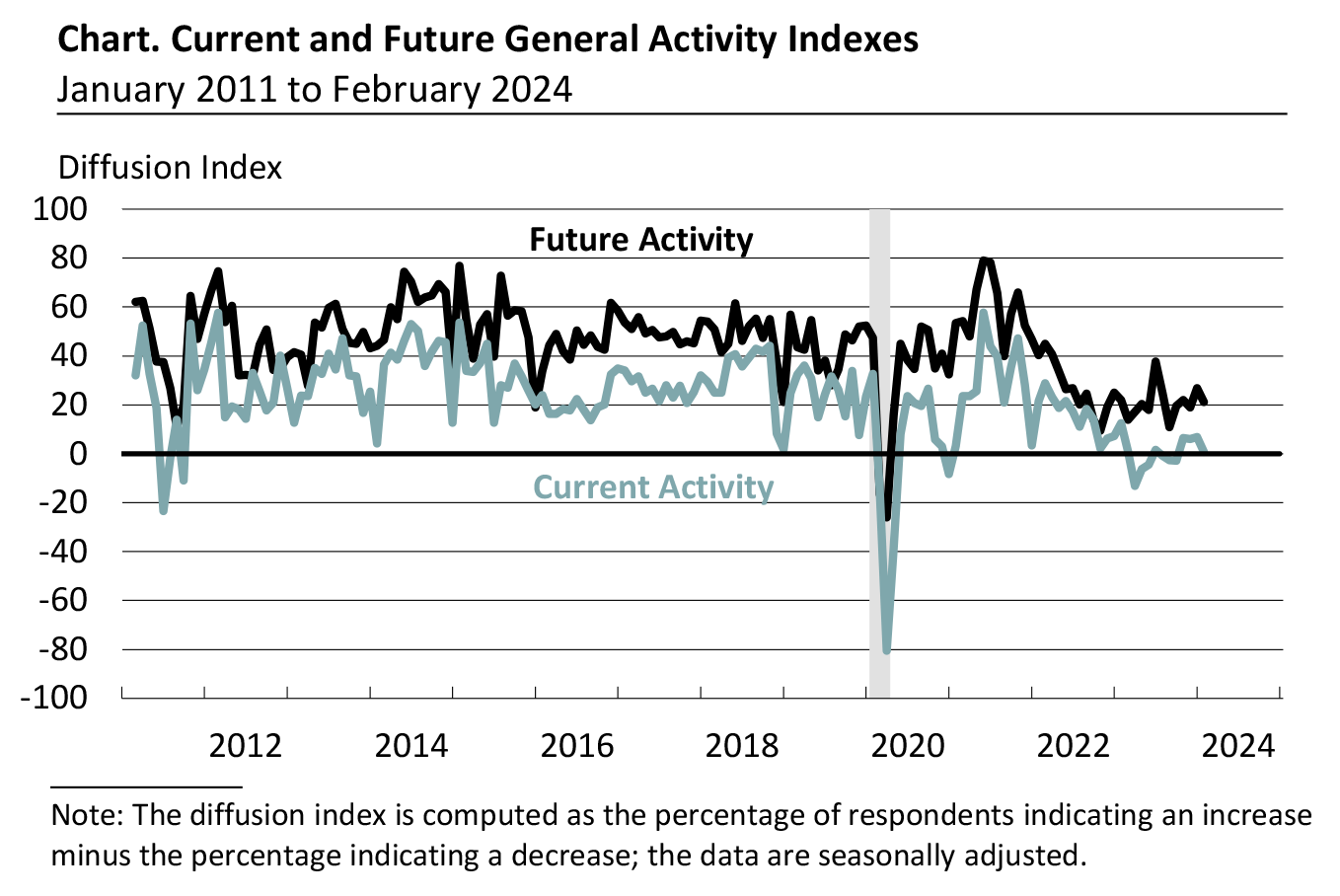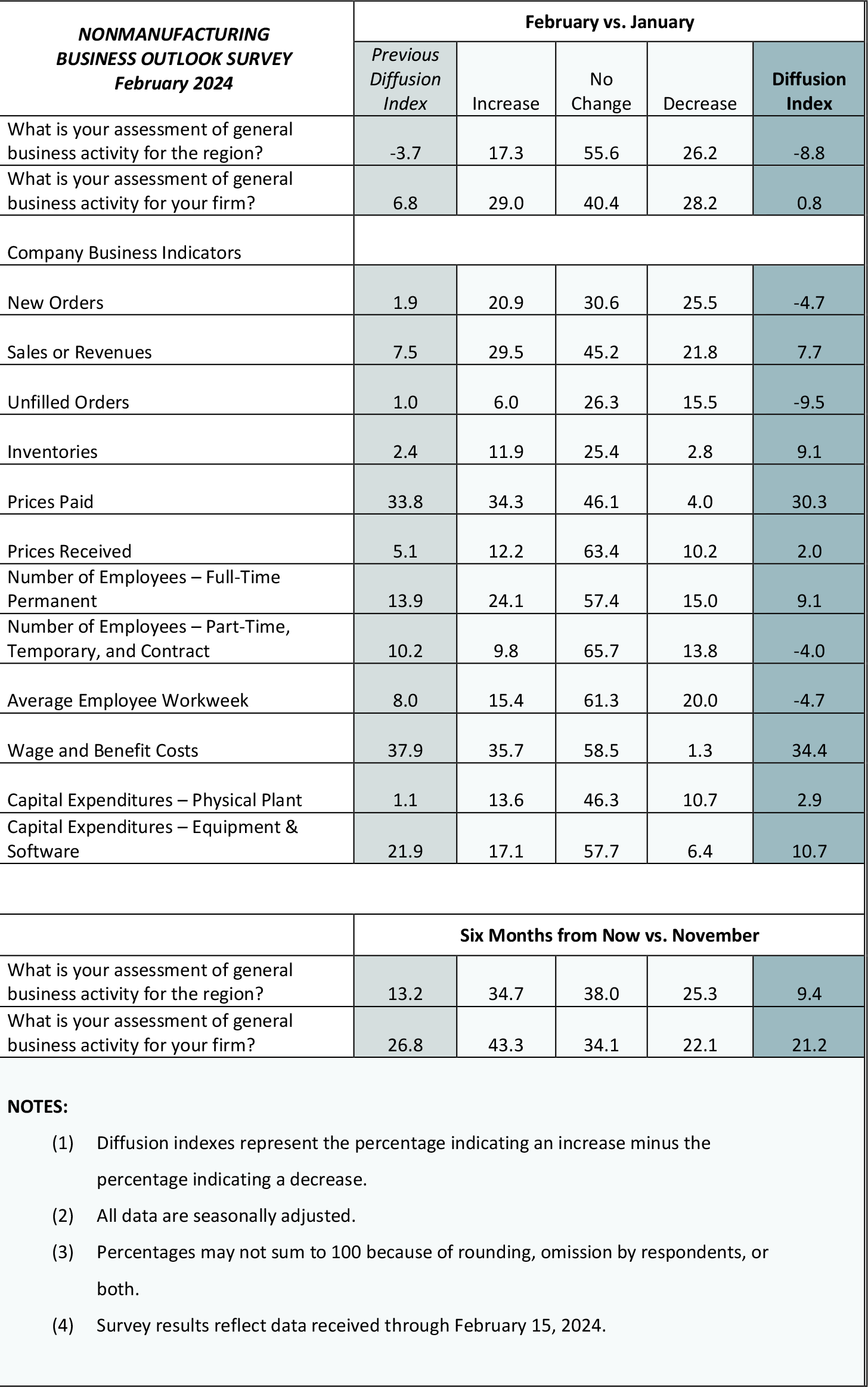February 2024 Nonmanufacturing Business Outlook Survey
Note: Survey responses were collected from February 5 to February 15.
Firms responding to the February Nonmanufacturing Business Outlook Survey indicated mostly steady business activity. The index for general activity at the firm level declined to a near-zero reading. The index for sales/revenues was little changed, while the index for new orders turned negative. On balance, the firms continued to report an increase in full-time employment this month. The prices paid index moved lower but continued to indicate overall increases in prices. The respondents continue to expect growth at their own firms and in the region over the next six months.

Most Current Indicators Weaken
The diffusion index for current general activity at the firm level decreased from 6.8 in January to 0.8 in February (see Chart). Twenty-nine percent of the firms reported increases in activity, narrowly edging out the 28 percent that reported decreases; 40 percent of the firms reported no change in activity. The new orders index returned to negative territory, falling 7 points -4.7 in February. This is the index’s 11th negative reading in the past 12 months. Almost 26 percent of the firms reported decreases in new orders, while 21 percent reported increases. The sales/revenues index was little changed at 7.7 this month. Nearly 30 percent of the firms reported increases in sales/revenues, while 22 percent reported decreases; 45 percent reported no change. The current regional activity index declined 5 points to -8.8.
Firms Report Overall Increases in Full-Time Employment
The firms reported increases in full-time employment this month on balance, but the index declined 5 points to 9.1. The share of firms reporting increases in full-time employment (24 percent) exceeded the share reporting decreases (15 percent); most firms (57 percent) reported no change. The part-time employment index turned negative, dropping 14 points to -4.0. Almost 66 percent of the firms reported steady part-time employment, while 14 percent reported decreases and 10 percent reported increases. The average workweek index fell 13 points to -4.7.
Firms Continue to Report Price Increases
Price indicators suggest continued but less widespread increases in prices for inputs and the firms’ own goods and services. The prices paid index fell 4 points to 30.3, its lowest reading since June. More than 34 percent of the firms reported increases in input prices, while 4 percent reported decreases; 46 percent reported stable prices. Regarding prices for the firms’ own goods and services, the prices received index fell from 5.1 to 2.0. Most of the firms (63 percent) reported no change in prices received, while the share reporting increases (12 percent) narrowly exceeded the share reporting decreases (10 percent).
Firms Expect Lower Increases in Own Prices
In this month’s special questions, the firms were asked to forecast the changes in prices of their own products and for U.S. consumers over the next four quarters. Regarding their own prices, the firms’ median forecast was for an increase of 2.0 percent, down from 3.0 percent when the question was last asked in November. The firms’ reported own price change over the past year was 0.3 percent, down from 3.0 in November. The firms expect their employee compensation costs (wages plus benefits on a per employee basis) to rise 4.0 percent over the next four quarters, unchanged from November. When asked about the rate of inflation for U.S. consumers over the next year, the firms’ median forecast was 3.0 percent, down from 3.5 percent last quarter. The firms’ median forecast for the long-run (10-year average) inflation rate was 3.5 percent, up from 3.0 percent in November.
Firms Anticipate Growth
The future activity indexes continued to suggest firms expect growth over the next six months. The diffusion index for future activity at the firm level fell 6 points to 21.2 in February. More than 43 percent of the firms expect increases in future activity at their firms, and 22 percent expect decreases. The future regional activity index fell from 13.2 to 9.4 this month.
Summary
Responses to this month’s Nonmanufacturing Business Outlook Survey suggested mostly steady nonmanufacturing activity in the region. The indicator for firm-level general activity fell to a near-zero reading. The sales/revenues index was little changed, but the new orders index turned negative this month. The index for full-time employment suggested overall increases in employment. The prices paid index continued to indicate less widespread price increases overall. The firms continue to expect growth over the next six months.
Special Questions (February 2024)
| Please list the annual percent change with respect to the following: | ||
|---|---|---|
|
|
Current |
Previous (Nov. 2023) |
| For your firm: | ||
| Forecast for next year (2024Q1–2025Q1) | ||
| 1. Prices your firm will receive (for its own goods and services sold). | 2.0 | 3.0 |
| 2. Compensation your firm will pay per employee (for wages and benefits). | 4.0 | 4.0 |
| Last year's price change (2023Q1–2024Q1) | ||
| 3. Prices your firm did receive (for its own goods and services sold) over the last year. | 0.3 | 3.0 |
| For U.S. consumers: | ||
| 4. Prices U.S. consumers will pay for goods and services over the next year. | 3.0 | 3.5 |
| 5. Prices U.S. consumers will pay for goods and services over the next 10 years (2024–2033). | 3.5 | 3.0 |
| The numbers represent medians of the individual forecasts (percent changes). For question 5, firms reported a 10-year annual-average change. | ||
Summary of Returns (February 2024)

Return to the main page for the Nonmanufacturing Business Outlook Survey.